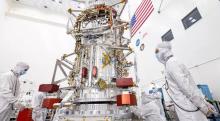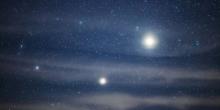Jupiter
Giant star to be eclipsed
Betelgeuse, one of the largest and brightest stars in the night sky will momentarily disappear some time on Monday night into Tuesday dawn as an asteroid passes in front of it, causing a phenomenon that scientists on Earth will witness for the first time.
- Read more about Giant star to be eclipsed
- Log in to post comments
New space telescope shows Jupiter’s auroras, tiny moons
The world's newest and biggest space telescope is showing Jupiter as never before, auroras and all.
Scientists released the shots on Aug. 22 of the solar system's biggest planet.
Europa Clipper takes big step toward launch
NASA's Europa Clipper mission is one step closer to starting its journey to Jupiter's icy moon.
The main body of Europa Clipper is an aluminum cylinder that clocks in at 10 feet (3 meters) tall and 5 feet (1.5 m) wide.
- Read more about Europa Clipper takes big step toward launch
- Log in to post comments
NASA sends quote by Nobel-winning Turkish author into space
A quote by the Turkish Nobel laureate Orhan Pamuk was launched into space on a NASA space probe earlier this week, the author's publisher said on Oct. 18.
Comet from edge of solar system killed the dinosaurs: Study
Sixty-six million years ago, a huge celestial object struck off the coast of what is now Mexico, triggering a catastrophic "impact winter" that eventually wiped out three-quarters of life on Earth, including the dinosaurs.
A pair of astronomers at Harvard say they have now resolved long-standing mysteries surrounding the nature and origin of the "Chicxulub impactor."
Sky enthusiasts enjoy view of conjunction
Skygazers all around the world enjoyed the view of a lifetime on Dec. 21 night as two gas giants appeared very close together in the night sky.
"Skywatchers are enjoying a once-in-a-lifetime look at a close alignment of Jupiter and Saturn!" NASA said on Twitter.
Called the great conjunction, the rare sight occurred at about 18:20 UTC, according to timeanddate.com.
- Read more about Sky enthusiasts enjoy view of conjunction
- Log in to post comments
Jupiter and Saturn 'Great conjunction' on Winter Solstice
On 21 December 2020, the planets aligned, appearing closer than they have since the middle ages, in what is being called a 'Christmas kiss'
Jupiter, Saturn to form double planet on Dec 21
In a once in 20 years occurrence, Jupiter and Saturn will appear very close together in the night sky on Dec. 21.
The two gas giants will actually be hundreds of millions of miles apart but will appear exceptionally close, just a tenth of a degree apart or one-fifth of a full moon's diameter, according to Live Science.
- Read more about Jupiter, Saturn to form double planet on Dec 21
- Log in to post comments
Scientists Discovered Water Vapors on Jupiter's Moon Europe
NASA's Maryland Space Center experts in have confirmed that there are traces of water vapor above the surface of Jupiter's icy moon Europa, Science Alert reported.
They analyzed data obtained from the Hawaiian Keck Observatory over 17 observations with a spectrograph to study the chemical compositions of other planets' atmospheres by scanning the infrared light they release or absorb
100kg Fireball Flew Over the US State of Missouri (VIDEO)
A meteor weighing nearly 100 kg flew over the US state of Missouri. The phenomenon was observed on Monday night.
NASA has released details of the phenomenon that happened.










